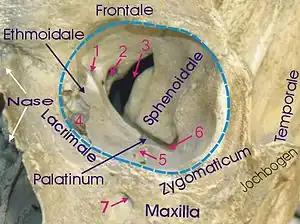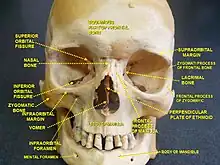Superior orbital fissure
| Superior orbital fissure | |
|---|---|
 1 Foramen ethmoidale, 2 Canalis opticus, 3 Fissura orbitalis superior, 4 Fossa sacci lacrimalis, 5 Sulcus infraorbitalis, 6 Fissura orbitalis inferior, 7 Foramen infraorbitale | |
| Details | |
| Part of | sphenoid bone |
| System | skeletal |
| Latin | fissura orbitalis superior |
| Anatomical terms of bone | |
The superior orbital fissure is a foramen or cleft in the skull. It lies between the lesser and greater wings of the sphenoid bone. It allows for many structures to pass, including the oculomotor nerve, the trochlear nerve, the ophthalmic nerve, the abducens nerve, the ophthalmic vein, and sympathetic fibres from the cavernous plexus.
Structure
The superior orbital fissure lies between the lesser and greater wings of the sphenoid bone.[1] It is between the optic canal (in front) and the foramen rotundum (behind).[1]
Structures passing through
A number of important anatomical structures pass through the fissure, and these can be damaged in orbital trauma, particularly blowout fractures through the floor of the orbit into the maxillary sinus. These structures are:
- superior and inferior divisions of oculomotor nerve (III).[2][3]
- trochlear nerve (IV).[2]
- lacrimal, frontal and nasociliary branches of ophthalmic (V1).[2]
- abducens nerve (VI).[2]
- superior and inferior divisions of ophthalmic vein (the Inferior division also passes through the inferior orbital fissure).[2]
- sympathetic fibres from the cavernous nerve plexus.[2]
It is divided into 3 parts from lateral to medial:
- Lateral part transmits: superior ophthalmic vein, lacrimal nerve, frontal nerve, trochlear nerve (CN IV), recurrent meningeal branch of lacrimal artery (anastomotic branch of lacrimal artery with the middle meningeal artery)
- Middle part transmits: Superior and inferior divisions of the oculomotor nerve (CN III), nasociliary nerve (lies between the two divisions of oculomotor nerve) and abducent nerve
- Medial part transmits: Inferior ophthalmic veins and sympathetic nerves arising from the plexus that accompanies the internal carotid artery
Variation
The superior orbital fissure is usually 22 mm wide in adults.[1]
Clinical significance

The abducens nerve is most likely to show signs of damage first, with the most common complaints retro-orbital pain and the involvement of cranial nerves III, IV, V1, and VI without other neurological signs or symptoms. This presentation indicates either compression of structures in the superior orbital fissure or the cavernous sinus.
Superior orbital fissure syndrome, is a neurological disorder that occurs when the superior orbital fissure is fractured.
See also
References
- 1 2 3 Weinzweig, Jeffrey; Taub, Peter J.; Bartlett, Scott P. (2010). "46 - Fractures of the Orbit". Plastic Surgery Secrets Plus (2nd ed.). Chicago: Mosby. pp. 299–307. doi:10.1016/B978-0-323-03470-8.00046-6. ISBN 978-0-323-03470-8. Archived from the original on 2021-08-18. Retrieved 2022-01-15.
- 1 2 3 4 5 6 Barral, Jean-Pierre; Crobier, Alain (2009-01-01). "9 - Manipulation of the plurineural orifices". Manual Therapy for the Cranial Nerves. Churchill Livingstone. pp. 51–57. doi:10.1016/B978-0-7020-3100-7.50012-4. ISBN 978-0-7020-3100-7. Archived from the original on 2022-03-05. Retrieved 2022-01-15.
{{cite book}}: CS1 maint: date and year (link) - ↑ Patel, Swetal (2015). "20 - The Oculomotor Nerve". Nerves and Nerve Injuries. Vol. 1: History, Embryology, Anatomy, Imaging, and Diagnostics. Academic Press. pp. 305–309. doi:10.1016/B978-0-12-410390-0.00021-4. ISBN 978-0-12-410390-0. Archived from the original on 2021-08-18. Retrieved 2022-01-15.